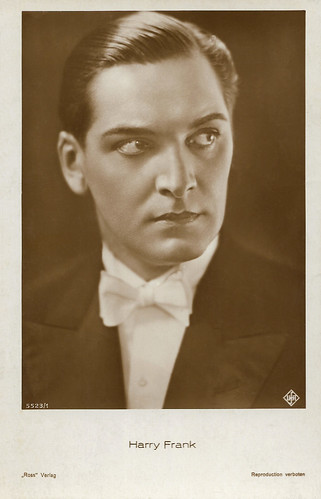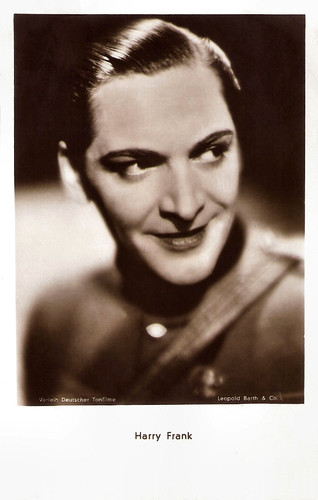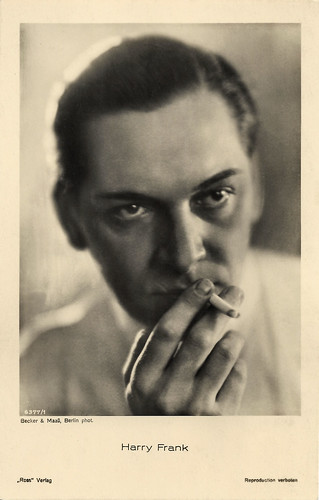German actor Harry Frank (1896-1947) appeared in several comedies and Krimis of the 1920s and 1930s, often as a smart, agile guy. At the beginning of his career, he appeared in films by famous directors Fritz Lang and Friedrich Wilhelm Murnau. Or is it true that two Harry Franks were active in the German cinema?

German postcard by Ross Verlag, no. 5121/1, 1930-1931. Photo: Ufa.

German postcard by Ross Verlag, no. 5523/1, 1930-1931. Photo: Ufa.

German postcard by Ross Verlag, no. 5524/1, 1930-1931. Photo: Hegewald-Film.
Harry Frank was born Helmut Franck in Berlin, Germany in 1896. He grew up in Lübeck and worked odd jobs like salesman, sailor and magician.
During the First World War, he was an officer in Turkey. After the war, he worked as a reporter for a provincial journal. Then he started to appear in films, first as a supporting player, later as the leading man. He made his film debut in In den Krallen des Vampyrs/In the Krall of the Vampyr (Wolfgang Neff, 1919).
The following year director Wolfgang Neff engaged him again for crime films like Der Spitzel/The Snitch (Wolfgang Neff, 1920) with Oscar Marion, and Der Mann in der Falle/The Man in the Trap (Wolfgang Neff, 1920). Under Fritz Lang, he acted in the silent German Western Die Spinnen/The Spiders (Fritz Lang, 1919) starring Carl de Vogt, in the drama Harakiri (Fritz Lang, 1919), in the romance Das wandernde Bild/The Moving Image (Fritz Lang, 1920) with Mia May, and Vier um die Frau/Four Around a Woman (Fritz Lang, 1921)* starring Carola Toelle.
He also appeared with Mia May in Der Leidensweg der Inge Krafft/The Ordeal of Inge Krafft (Robert Dinesen, 1921). After that he appeared in two films by Friedrich Wilhelm Murnau, the lost film Marizza, genannt die Schmugglermadonna Marizza, Called the Smugglers' Madonna (F.W. Murnau, 1922) and the drama Der brennende Acker/Burning Soil (F.W. Murnau, 1922) with Werner Krauss and Lya de Putti.
Then there was an interval in his film career till 1927. That year he appeared in films like Der Fidele Bauer/The Merry Farmer (Frans Seitz, 1927) starring Carmen Boni, Almenrausch und Edelweiss(Frans Seitz, 1928) with Walter Slezak, Flucht aus der Hölle/Escape from Hell (Georg Asagaroff, 1928) with Fritz Alberti, Liebeshölle/Pawns of Passion (Wiktor Bieganski, Carmine Gallone, 1928), and Hotelgeheimnisse/Hotel Secrets (Friedrich Feher, 1929) with Magda Sonja.

German postcard by Ross Verlag, no. 5370/1, 1930-1931. Photo: Deutsche Universal-Film. Camilla Horn and Harry Frank in Die große Sehnsucht/The Great Passion (Steve Sekely, 1930).

German postcard by Ross Verlag, no. 5495/1, 1930-1931. Photo: Süd-Film. Harry Frank and Fee Malten in Der falsche Feldmarschall/The Fake Field Marshal (Karel Lamac, 1930).

Austrian postcard by Iris Verlag, no. 6007. Photo: Verleih Deutscher Tonfilme / Leopold Barth & Co.
Harry Frank specialised in smart, agile characters in comedies and Krimis (German crime films). After the introduction of the sound film, he continued his film career in successful films like Der Tiger/The Tiger Murder Case (Johannes Meyer, 1930) with Charlotte Susa and Die Große Sehnsucht/The Great Passion (Steve Sekely, 1930) with Camilla Horn.
He also appeared in costume films like Der Falsche Feldmarschall/Fake Field Marshal (Carl Lamac, 1930), and the historical epic Der Choral von Leuthen/The Anthem of Leuthen (1933) with Otto Gebühr. Till 1936 he appeared each year in several films. Later his popularity clearly diminished and he focused more on the stage. He often performed in the Renaissance Theatre.
In the cinema he was seen in a small part in the two-part exotic extravaganza Der Tiger von Eschnapur/The Tiger of Eschnapur (Richard Eichberg, 1937) and Das indische Grabmal/The Indian Tomb (Richard Eichberg, 1938), both starring Frits van Dongen (Philip Dorn), La Jana and Gustav Diessl.
He made his last film in East Germany, the DEFA Krimi Razzia/Police Raid (Werner Klingler, 1947), in which he played a ruthless, dangerous criminal in post-war Berlin. In Berlin, Harry Frank died shortly afterwards in 1947 (or in 1948 according to Thomas Staedeli at Cyranos). He was 51.
* Wikipedia cites a source (Kay Weniger in Das große Personenlexikon des Films) who claims that there were two Harry Franks. The actor in the Fritz Lang films was not the actor mentioned above, but Thomas Staedeli, IMDb and Filmportal.de know only one Harry Frank.

French postcard. Photo: Artistes Associés. Collection: Didier Hanson.

German postcard by Ross Verlag, no. 6157/1, 1931-1932. Photo: Atelier Schneider, Berlin.

German postcard by Ross Verlag, no. 6377/1, 1931-1932. Photo: Becker & Maass, Berlin.
Sources: Thomas Staedeli (Cyranos), Volker Wachter (DEFA Filmsterne - now defunct), Wikipedia (German), Filmportal.de and IMDb.
This post was last updated on 11 April 2024.

German postcard by Ross Verlag, no. 5121/1, 1930-1931. Photo: Ufa.

German postcard by Ross Verlag, no. 5523/1, 1930-1931. Photo: Ufa.

German postcard by Ross Verlag, no. 5524/1, 1930-1931. Photo: Hegewald-Film.
Magician
Harry Frank was born Helmut Franck in Berlin, Germany in 1896. He grew up in Lübeck and worked odd jobs like salesman, sailor and magician.
During the First World War, he was an officer in Turkey. After the war, he worked as a reporter for a provincial journal. Then he started to appear in films, first as a supporting player, later as the leading man. He made his film debut in In den Krallen des Vampyrs/In the Krall of the Vampyr (Wolfgang Neff, 1919).
The following year director Wolfgang Neff engaged him again for crime films like Der Spitzel/The Snitch (Wolfgang Neff, 1920) with Oscar Marion, and Der Mann in der Falle/The Man in the Trap (Wolfgang Neff, 1920). Under Fritz Lang, he acted in the silent German Western Die Spinnen/The Spiders (Fritz Lang, 1919) starring Carl de Vogt, in the drama Harakiri (Fritz Lang, 1919), in the romance Das wandernde Bild/The Moving Image (Fritz Lang, 1920) with Mia May, and Vier um die Frau/Four Around a Woman (Fritz Lang, 1921)* starring Carola Toelle.
He also appeared with Mia May in Der Leidensweg der Inge Krafft/The Ordeal of Inge Krafft (Robert Dinesen, 1921). After that he appeared in two films by Friedrich Wilhelm Murnau, the lost film Marizza, genannt die Schmugglermadonna Marizza, Called the Smugglers' Madonna (F.W. Murnau, 1922) and the drama Der brennende Acker/Burning Soil (F.W. Murnau, 1922) with Werner Krauss and Lya de Putti.
Then there was an interval in his film career till 1927. That year he appeared in films like Der Fidele Bauer/The Merry Farmer (Frans Seitz, 1927) starring Carmen Boni, Almenrausch und Edelweiss(Frans Seitz, 1928) with Walter Slezak, Flucht aus der Hölle/Escape from Hell (Georg Asagaroff, 1928) with Fritz Alberti, Liebeshölle/Pawns of Passion (Wiktor Bieganski, Carmine Gallone, 1928), and Hotelgeheimnisse/Hotel Secrets (Friedrich Feher, 1929) with Magda Sonja.

German postcard by Ross Verlag, no. 5370/1, 1930-1931. Photo: Deutsche Universal-Film. Camilla Horn and Harry Frank in Die große Sehnsucht/The Great Passion (Steve Sekely, 1930).

German postcard by Ross Verlag, no. 5495/1, 1930-1931. Photo: Süd-Film. Harry Frank and Fee Malten in Der falsche Feldmarschall/The Fake Field Marshal (Karel Lamac, 1930).

Austrian postcard by Iris Verlag, no. 6007. Photo: Verleih Deutscher Tonfilme / Leopold Barth & Co.
Exotic extravaganza
Harry Frank specialised in smart, agile characters in comedies and Krimis (German crime films). After the introduction of the sound film, he continued his film career in successful films like Der Tiger/The Tiger Murder Case (Johannes Meyer, 1930) with Charlotte Susa and Die Große Sehnsucht/The Great Passion (Steve Sekely, 1930) with Camilla Horn.
He also appeared in costume films like Der Falsche Feldmarschall/Fake Field Marshal (Carl Lamac, 1930), and the historical epic Der Choral von Leuthen/The Anthem of Leuthen (1933) with Otto Gebühr. Till 1936 he appeared each year in several films. Later his popularity clearly diminished and he focused more on the stage. He often performed in the Renaissance Theatre.
In the cinema he was seen in a small part in the two-part exotic extravaganza Der Tiger von Eschnapur/The Tiger of Eschnapur (Richard Eichberg, 1937) and Das indische Grabmal/The Indian Tomb (Richard Eichberg, 1938), both starring Frits van Dongen (Philip Dorn), La Jana and Gustav Diessl.
He made his last film in East Germany, the DEFA Krimi Razzia/Police Raid (Werner Klingler, 1947), in which he played a ruthless, dangerous criminal in post-war Berlin. In Berlin, Harry Frank died shortly afterwards in 1947 (or in 1948 according to Thomas Staedeli at Cyranos). He was 51.
* Wikipedia cites a source (Kay Weniger in Das große Personenlexikon des Films) who claims that there were two Harry Franks. The actor in the Fritz Lang films was not the actor mentioned above, but Thomas Staedeli, IMDb and Filmportal.de know only one Harry Frank.

French postcard. Photo: Artistes Associés. Collection: Didier Hanson.

German postcard by Ross Verlag, no. 6157/1, 1931-1932. Photo: Atelier Schneider, Berlin.

German postcard by Ross Verlag, no. 6377/1, 1931-1932. Photo: Becker & Maass, Berlin.
Sources: Thomas Staedeli (Cyranos), Volker Wachter (DEFA Filmsterne - now defunct), Wikipedia (German), Filmportal.de and IMDb.
This post was last updated on 11 April 2024.
That would be wild if there were really two of them!
ReplyDelete